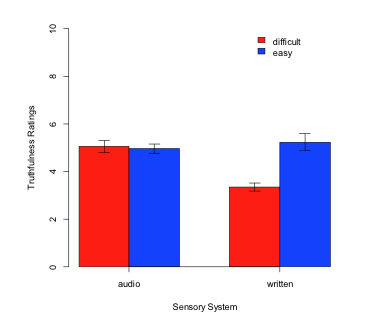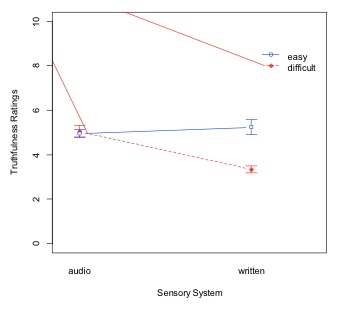Featured Article:The Effects of Processing and Sensory Systems on Perceptual Fluency
By
2012, Vol. 4 No. 06 | pg. 2/2 | « ResultsUsing descriptive statistics, we were able to evaluate the perceptual fluency of each undergraduate psychology student within our sample under two conditions of information dispensation: audio and written. We then broke these groups down even further based on the processing level at which students received each statement. Student responses were thus evaluated under one of four possible groups: easy within audio, difficult within audio, easy within written, and difficult within written. To begin with, we must first quantify the random distribution of participants within each subset: 12 participants were randomly assigned to the difficult-audio sample, 18 participants were randomly assigned to the difficult-written sample, 21 participants were randomly assigned to the easy-audio sample, and 13 participants were randomly assigned to the easy-written sample. The overall audio group had a marginal count of 33 while the overall written group had a marginal count of 31. Similarly, the overall difficult group had a marginal count of 30 while the overall easy group had a marginal count of 34.The mean value of the difficult-audio subset came out to be 5.05 while the mean value of the difficult-written subset amounted to 3.34. The mean value of the easy-audio subset, however, came out to be 4.96 while the mean value of the easy-written subset stood at 5.24. The standard deviation of the difficult-audio subset came out to be 0.90 while the standard deviation of the difficult-written subset amounted to 0.71. The standard deviation of the easy-audio subset, however, came out to be 0.86 while the standard deviation of the easy-written subset stood at 1.23. When comparing the mean values between the difficult and easy processing groups, we found that the overall difficult group sustained a mean value of 4.03 while the easy processing group possessed a mean value of 5.06. After conducting a two sample t-test with an alpha level of 0.025, we also computed a p-value of 0.00 which denoted the absence of a main effect with statistical significance as p > 0.05. When comparing the mean values between the audio and written sensory groups, we found that the overall audio sensory group sustained a mean value of 4.99 while the written sensory group possessed a mean value of 4.14. After conducting a two sample t-test with an alpha level of 0.025, we also computed a p-value of 0.00 which denoted the absence of a main effect with statistical significance as p > 0.05. When comparing the mean values of easy versus difficult processing levels within the audio sensory group, we found the easy-audio mean value to be 4.96 while the difficult-audio mean value amounted to 5.05. After conducting a two sample t-test with an alpha level of 0.025, we also computed a p-value of 0.77 which denoted the absence of a main effect with statistical significance as p > 0.05. When comparing the mean values of easy versus difficult processing levels within the written sensory group, we found the easy-written mean value to be 5.24 while the difficult-written mean value amounted to 3.34. After conducting a two sample t-test with an alpha level of 0.025, we also computed a p-value of 7.79e-06 which denoted a main effect of statistical significance as p < 0.05. According to our bar graph and line plot, data findings indicate that there was no main effect in the audio condition, that there was a main effect in the written condition, and that there was no interaction between the conditions. Participants assigned to the easy-written condition notably scored the series of statements presented to them as having a higher strength of validity when compared to those assigned to the difficult-written condition. DiscussionThe suspicious correlation between the reduction in tax dollars and the decline in high school graduation rates has procured a growing interest in both the educational and political spectrums. The majority of tax payers within the United States have decidedly lost faith in their federal government’s ability to provide for U.S. citizens in an efficient manner, and have moreover begun to lose trust in the ability of the nation’s educational institutions in implementing effective learning programs that are ultimately responsible for cultivating well-informed, responsible adults that will in turn affect policy and legislation in generations to come. Thus, politicians and educators alike would do well to consider the importance of perceptual fluency and how the sensory systems and processing systems may either enhance social wellbeing or facilitate social regression. To analyze these effects, we chose to assess the perceptual fluency of a common population of young adults working towards becoming contributing members of society so as to project in what way these future policymakers would be most influenced and by what systems – that is to say, we began our experiment analyzing the perceptual fluency of the undergraduate college student. In order to determine the roles of the sensory systems and processing levels in college undergraduates’ perceptual fluency, we constructed a 2x2 factorial design to examine the effects of audio versus written presentation models and difficult versus easy processing levels on students’ perception of statement validity. Earlier in this paper, we also noted that previous research conducted on perceptual fluency bears a narrow focus towards the visual assessment of perceptual fluency while neglecting to examine the effects of clarity distortion under auditory means. By extension, we also sought to compare perceptual fluency between sensory systems and between the processing systems as well. Data findings suggest that there was a statistically significant main effect observed only under the written condition and that there was no observable main effect under the audio condition of statistical significance nor was there a concrete interaction between the conditions. Reber and Schwarz (1999) mention a similar finding in their study of perceptual fluency on judgments of truth. They also refute concerns that statements presented on distorted visual presentation models may have a substantially greater likelihood of being deemed false simply because viewers are confronted with greater difficulty in reading the statements or do not make the effort in determining each statement’s strength of validity due to inattention (Reber & Schwarz, 1999). If this were the case, they explain, “one would expect differential effects in the different subsets” of their research design – which was not the case with their data nor was it the case with ours (Reber & Schwarz, 1999). Previous research does reflect, however, a few of the prominent limitations we encountered in evaluating students’ perceptual fluency. Drummey and Newcombe (1995), for instance, remark that their implicit memory test further comprised of “recognition questions” which may have “impair[ed] their chances of showing perceptual facilitation effects…changing an implicit to an explicit task” (Drummey & Newcombe, 1995). Supposing then that our participants had had previous exposure to these facts and falsehoods prior to the study, one would suspect that these tests of perceptual fluency were in fact limited by the underlying presence of memory and recall. Carroll and her associates (1985) address this concern of distinguishing perceptual memory from recognition memory and refer to this distortion as “the oldness effect” (Carroll, Byrne & Kirsner, 1985). On the other hand, Carroll and her associates (1985) also contend that perceptual memory and recognition memory are independent of one another and that “perceptual memory…appears not to develop with age” (Carroll, Byrne & Kirsner, 1985). In which case, we may presumably extend our findings to the general population without being concerned with the infringement of age. However, we cannot acquit ourselves of the plausible breach that explicit memory may have imposed on the study. We also projected the expectation that participants who received statements via audio presentation models would rank the statements as having lower levels of validity when compared to the scores of those who received statements via visual mediums. Although neither of the studies mentioned above appear to explain why no such difference was observed, future studies may do well to analyze under what conditions the audio presentation model incurs a level of trust and authority from the receptor as there was no significant difference between participants who received the statements under either processing level within the audio sensory group. When compared to students’ responses recorded under the umbrella written sensory group, however, one may even presume that students are more likely to trust their instincts or hold stronger opinions on statement validity when initial exposure occurs via visual (written) mediums as opposed to audio-based mediums. This, of course, is merely speculation as further experimental evidence is necessary to conclude a definitive causal relationship. ReferencesU.S. Department of Education, (2012).Overview: The federal role in education. Retrieved from website: http://www2.ed.gov/about/overview/fed/role.html Jones, J. M. (2011). Americans say government wastes over half of every dollar. InGallup Politics Princeton, NJ: Gallup, Inc. Retrieved from http://www.gallup.com/poll/149543/Americans-Say-Federal-Gov-Wastes-Half-Every-Dollar.aspx U.S. Department of Education, Institute of Education Sciences: National Center for Education Statistics. (2011).Fast facts. Retrieved from website: http://nces.ed.gov/fastfacts/display.asp?id=1 Statistics on american k-12 public education. (2012). Retrieved from http://broadeducation.org/about/crisis_stats.html Drummey, A. B., & Newcombe, N. (1995). Remembering versus knowing the past: Children.Journal of Experimental and Child Psychology,59(3), 549-565. Retrieved from http://www.sciencedirect.com/science/article/pii/S0022096585710259 Carroll, M., Byrne, B., & Kirsner, K. (1985). Autobiographical memory and perceptual learning: A developmental study using picture recognition, naming latency, and perceptual identification. Memory and Cognition,13(3), 273-279. Retrieved from http://www.springerlink.com/content/263442244mx75732/ Reber, R., & Schwarz, N. (1999). Effects of perceptual fluency on judgments of truth.Consciousness and Cognition,8, 338-342. Retrieved from https://courses.utexas.edu/bbcswebdav/courses/2012_spring_43130_PSY_418/Reber & Schwarz 1999.pdf AppendixNumber of Participants within Each Subset
Marginal Counts
Mean Values of Each Subset
Standard Deviation within Each Subset
Overall Comparison of Mean Values (Easy v. Difficult)
Overall Comparison of Mean Values (Audio v. Written)
Comparison of Mean Values Using Two Sample t-test Between-Subjects Effects
Mean Comparison of Easy v. Difficult within AUDIO
Mean Comparison of Easy v. Difficult within WRITTEN
Comparison of Mean Values Using Two Sample t-test Within-Subjects Effects
Measurements of Statement Validity (Bar Graph)
Measurements of Statement Validity (Line Plot)
Sample Statements Rated on Survey Sheet
Suggested Reading from Inquiries Journal
Inquiries Journal provides undergraduate and graduate students around the world a platform for the wide dissemination of academic work over a range of core disciplines. Representing the work of students from hundreds of institutions around the globe, Inquiries Journal's large database of academic articles is completely free. Learn more | Blog | Submit Latest in Psychology |
























